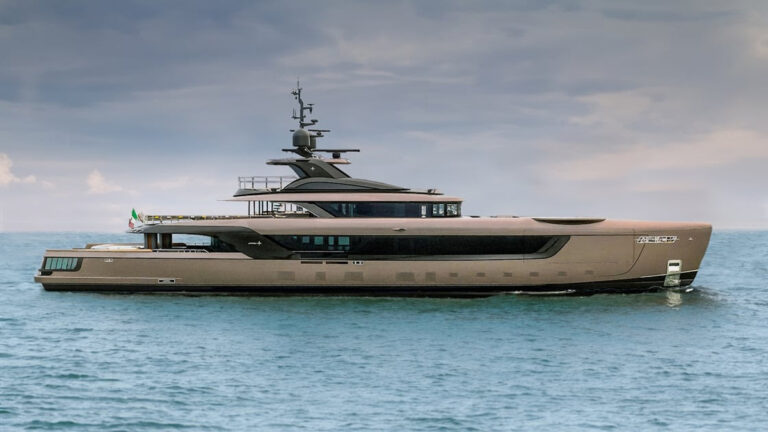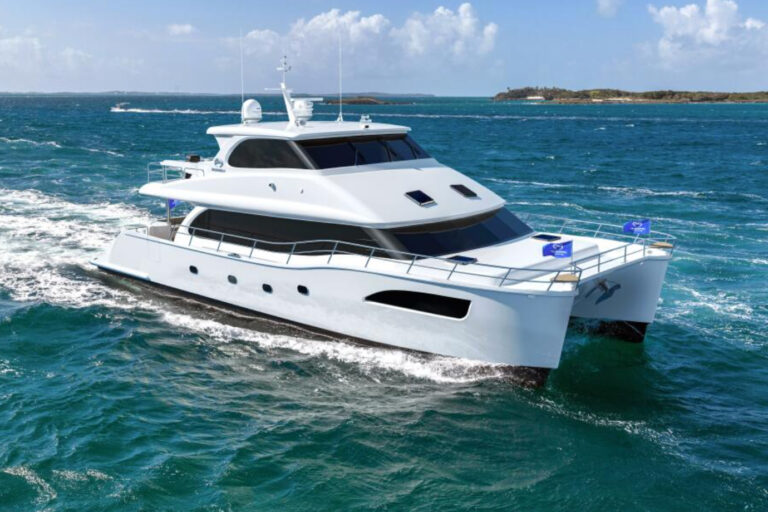You can enjoy a baseball game without ever caring about Mickey Mantle or Ebbets Field, just as you can buy a painting without knowing a Monet from a Manet. You can savor Monday Night Football without remembering who won the first Super Bowl (Green Bay) and your kids can play soccer without thinking of Pelé. You can own a house without understanding the contributions of Frank Lloyd Wright to architecture, and you can drive a car without knowing who invented the rearview mirror.
But knowing the traditions and the heritage behind your passion, whether it’s baseball or art or cars-or yachting-can add to your enjoyment and understanding of the sport.
Yachting was first the sport of kings in Europe, who commissioned luxuriously appointed vessels of state as far back as the mid-1600s, and the word “yacht” derives from the Dutch word jaght. The first yacht club was the Royal Cork Yacht Club, formed in 1720 in Ireland, which served as an unofficial coast guard that sponsored “chases” or races.
But America was too busy using its vessels for fishing, trading, or throwing out the Brits to fool around with yachts, at least until after the War of 1812. From that point on, during the 124 years from 1815 to the beginning of World War II, America became a world power in yachting.
Cleopatra’s Barge
It all started with a dandy named George Crowninshield, the foppish heir to a shipping fortune, who commissioned a pleasure yacht for himself in 1816. Named Cleopatra’s Barge, she was the nautical version of the wildly painted carriages that Crowninshield favored ashore. She sported colorful stripes on the starboard side, while the port hull had a herringbone pattern. Velvet ropes surrounded the cockpit and, below, the yacht was the epitome of decadent luxury: tassels and gold leaf, gilt chandeliers, and inlaid mahogany. She was quirky, too, from her paint scheme to the tall cigar-store Indian in full warpaint bolted to the deck.
A privateer and smuggler during the War of 1812, Crowninshield decided to do a “Grand Tour” of Europe and, in 1817, set off for the Mediterranean where he showed off his new toy to celebrities and heads of state, including the Bonaparte family. Returning to America, Crowninshield might have made yachting all the rage, had he not died suddenly. Cleopatra’s Barge fell into disrepair and ended up in Hawaii as the royal yacht for King Kamehameha, where she eventually was wrecked on a reef: a sad end to the first American luxury yacht.
The New York Yacht Club and America
There remained a certain “competitiveness” between America and Britain after the war, so when word arrived in the former colonies that the British were planning a yacht race around the Isle of Wight in 1851, it seemed a wonderful opportunity to the members of the New York Yacht Club, which had been formed in 1844. Led by Commodore John Cox Stevens and negotiated by George Schuyler, a schooner yacht named America was commissioned for just this purpose. Built on the lines of the fast pilot schooners of the East Coast, she trounced the British competitors. In fact, America left the others so far behind that Queen Victoria, who watched as America finished, asked about the other yachts and was given the (probably apocryphal) response “Your Majesty, there is no second.”
America thus won the 100 Guineas Cup, an exceptionally ugly (and bottomless) silver trophy that, in years to come, would be known as The America’s Cup, and which has been the most important yachting trophy for 158 years.
Early Power
The Civil War interrupted yachting but it wasn’t long before the wealthy were back on the water in what became known as the Gilded Age of Yachting. In 1880, the largest steam yacht in the NYYC fleet was a 146-footer owned by New York Herald publisher, James Gordon Bennett, Jr., and, by 1886, the title was assumed by William K. Vanderbilt’s 285-foot Alva. In 1890, it was back to Bennett with his 314-foot Lysistrata. The era of the superyacht was born.
The turn of the century also created the age of power, with ever larger and faster boats being built as the internal combustion engine replaced steam.
The Harmsworth Cup for speed on the water was another British trophy squarely in the sights of Americans. In 1903, the Cup was won by the British at a then-astounding 19.5 mph, but an American boat, the aptly named Dixie, swept to victory at 31 mph in 1907.
In 1916, the Gold Cup racer, Miss Minneapolis, turned the world upside down by breaking the mile-a-minute barrier. The racer was built by Christopher Columbus Smith, whose name would soon identify the company that gave America the pleasure boat: Chris-Craft.
After World War I, the Harmsworth Cup became the private turf of Gar Wood from 1920 to 1949 with his series of Miss America racers that he built and designed, pushing the speed to 86 mph in the process.
There were races of another type as well, but they were informal matches of one-upsmanship among the scions of New York, who built larger and faster commuter yachts to carry them from their estates to docks at the foot of Wall Street. As early as 1890, J.P. Morgan was using his second Corsair, a mere 242-footer, to commute to Manhattan. Publisher William Randolph Hearst’s Vamoose was an early 112-footer designed and built by Nathanael Herreshoff to carry Hearst from his Long Island estate to work at a speed of 27 mph. Another commuter, a Gar Wood-designed 70-footer named Cigarette for its slim 11-foot beam, was one of a series that would later lend its name to the famed performance sportboats of the ’60s.
Engines were changing, too. An inventor named C. B. Waterman pioneered the outboard motor in 1905, calling it the Porto Motor, but it wasn’t until 1909 that Ole Evinrude, weary of rowing to buy ice cream for his girlfriend, would develop the idea and spawn an industry that continues today.
During the same period, German engineer Rudolf Diesel had created the sparkless engine but, unfortunately, he didn’t live to see his invention embraced. Believing himself a failure, he vanished from a steamer in the English Channel, an apparent suicide. His name lives on in enginerooms everywhere.
Cruising and Racing
It wasn’t much of a challenge to cross the Atlantic aboard a 250-foot sail or power yacht, but two adventurers captured the imagination of the world around the turn of the century. Joshua Slocum was a down-on-his-luck ship’s captain when he rebuilt a derelict fishing boat, named her Spray, and became the first man to sail singlehanded around the world. His book, Sailing Alone Around the World, captured the imagination of the public when it was published in 1900 and he set the stage for generations of cruisers.
In 1912, Thomas Fleming Day, the editor of The Rudder magazine, decided to demonstrate the reliability of the internal combustion engine by cruising from New York to Russia aboard a 35-foot powerboat, aptly named Detroit. His book about the trip, The Voyage of Detroit, helped give yachting credibility. And, speaking of credibility, the first issue of Yachting magazine was eagerly snapped up in 1907, a start date that makes it the oldest boating magazine still in existence.
Racing was also coming into its own for the average yachtsman, and both the Bermuda Race and the transpacific Race were sailed for the first time in 1906.
At the more elite end of the scale, the NYYC was on its way to establishing the longest winning streak in history with the America’s Cup, as it trounced one challenger after another. The Herreshoff period from 1893 to 1920 featured winning yachts from Nathanael Herreshoff, and one of his most determined challengers was Sir Thomas Lipton, the English tea magnate who raced five times between 1899 and 1930. From 1929 to 1937 were the J-class years, when the huge 130-plus-foot sloops were sailed in spite of the Depression. Certainly the most successful was the Olin Stephens/Starling Burgess-designed Ranger, which was sailed by owner-skipper Harold “Mike” Vanderbilt to 35 wins in 37 races.
During the early 20th century, fishing went from being simply a trade or a way to put food on the table to a sport, and no one did more to make sportfishing legitimate than Ernest Hemingway. He commissioned Wheeler Yachts to build his 34-foot Pilar in 1934 and then fished (and drank) his way from Bimini to Cuba. He portrayed sportfishing as a bigger-than-life challenge in his books To Have and Have Not and The Old Man and The Sea-some of the greatest fishing tales ever told. Seen with a huge marlin on the cover of Time (December 13, 1954) and shown fighting fish on the pages of Life, he remains the very essence of machismo.
America may have been struggling through the depths of the great Depression but, in 1931, the launching of Hussar established new standards for luxury and lavish spending. Built for financier E.F. Hutton and his wife, cereal heiress Marjorie Merriweather Post, the 352-footer was the largest private sailing yacht ever built. After their divorce, she kept the yacht and renamed her Sea Cloud, which she remains to this day.
The Depression didn’t stop boatbuilders from experimenting with adapting automotive-style production-line techniques to their craft. In 1931, Chris-Craft introduced one of these whose name quickly became synonymous with pleasure boating: the cabin cruiser.
And, in a world that had been dominated by wood and steel yachts for millennia, a young man in Ohio was tinkering with a substance that would soon eclipse these as the material of choice for hulls. In the mid ’30s, Ray Greene had built a few small boats using melamine resin (the main ingredient in Formica) with cotton cloth reinforcing. in 1937, he wrote his college thesis on plastic for boatbuilding. In 1941, when Owens-corning Fiberglas began producing woven glass fibers, Greene was able to acquire some of the early glass-fiber fabric since he had done some work for the company. Using formaldehyde glues and what we now know as fiberglass, he built boat models in an autoclave. It was to change the face of boating forever.
But war clouds had already spread across Europe, and December 7, 1941, would end peace for America and curtail pleasure boating for the duration of World War II. Boatbuilders turned their efforts to war, with companies such as Chris-Craft shifting from runabouts to landing craft, while Huckins Yachts built PT Boats and Hinckley turned out coast guard picket boats.
Many large yachts, such as Corsair, were requisitioned as patrol boats and sub-hunters, and even Ernest Hemingway made anti-submarine forays into the Caribbean aboard Pilar. The war would last four years but, when it was over, America was ready to reclaim the throne as the yachting capital of the world. And to think it all started in 1816 with Crowninshield’s flamboyant yacht named Cleopatra’s Barge.









